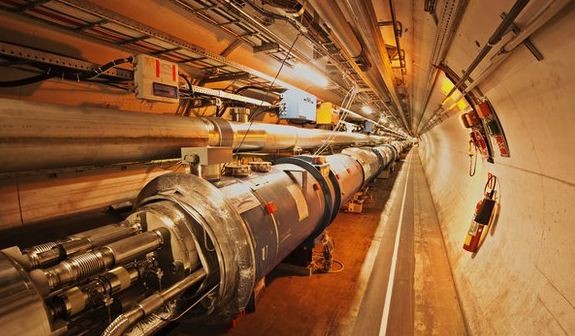The Large Hadron Collider (LHC), the world's largest particle collider, was successfully restarted Sunday (April 5), reported CERN or the European Organization for Nuclear Research that operates the mammoth machine.
CERN said two proton beams were circulated inside the machine's 27 kilometer long tunnel in opposite directions at their injection energy of 450 GeV within hours of the particle accelerator's restart. It announced particle beams traveled in both directions along parallel pipes at speeds slightly below the speed of light.
After 08:30 GMT, engineers began threading the proton beam through each section of the massive circle, one-by-one, before completing multiple full turns. It was later joined by the second beam, in parallel.
The experiment teams detected "splashes" of particles that occur when stray protons hit one of the shutters used to keep the beam on-track.
Over the next few months, engineers will gradually increase the beams' energy to 13 trillion electronvolts, double what it was during LHC's Season 1 operating run.
The reboot of the LHC saw the replacement of 18 of the accelerator's 1,232 superconducting dipole magnets that guide particle beams around the LHC.
The long-awaited particle collisions in Season 2 won't resume for at least another month, however.
"It's very satisfying for our operators to be back in the driver's seat, with what's effectively a new accelerator to bring on-stream, carefully, step by step," said Paul Collier, head of beams at CERN.
The more muscular LHC is expected to operate at almost twice the energy of its previous incarnation. More specifically, thanks to the work done in the last two years, the LHC will operate at unprecedented energy -- almost double that of Season 1 -- at 6.5 TeV per beam.
CERN said 13 TeV proton-proton collisions are expected before summer and the LHC's experiments will at last start exploring the exotic but uncharted realms of quantum physics.
Among the LHC's targets will be the Brout-Englert-Higgs mechanism, dark matter, antimatter and quark-gluon plasma. The Brout-Englert-Higgs mechanism or the Higgs mechanism is essential to explain the generation mechanism of the property "mass" for gauge bosons.
In Season 2, physicists will put the Standard Model of particle physics to its most stringent test yet as they search for new physics beyond this accepted theory, describing particles and their interactions.
The LHC was to have restarted last week. A short circuit aborted the reboot but has since been fixed.
After the restart, Rolf Heuer, CERN director-general, told engineers and scientists at the lab, "Congratulations. Thank you very much everyone ... now the hard work starts".
"After two years of effort, the LHC is in great shape," said CERN director for accelerators and technology, Frédérick Bordry.
"But the most important step is still to come when we increase the energy of the beams to new record levels."



























